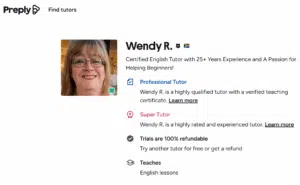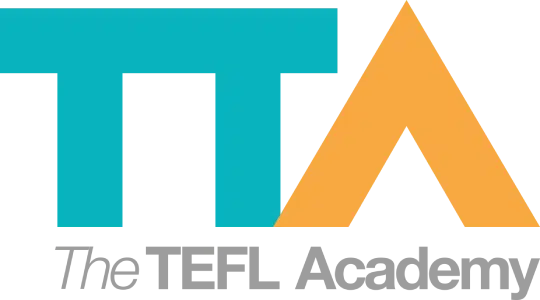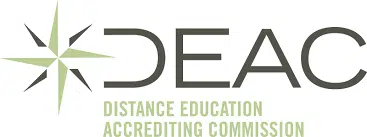Teaching On Preply: What You Need To Know
Join a global community of over 200,000 TEFL teachers working throughout the world! Enrol me!
With the plethora of online platforms offering English language lessons to learners, and teaching positions to English teachers and tutors, it is difficult to know which online teaching companies are legit.
We’re going to get to the bottom of this by asking those who know best: the teachers themselves.
In this series, we’ll talk to teachers currently teaching online in 2025 and ask them the important questions.
Meet Wendy, a Preply tutor.
Wendy, can you tell us a little bit about yourself?
I am Wendy Roxburgh, 61 years old, with a B.A. and H.Dip.Ed(PG) from the University of the Witwatersrand, awarded in 1987. I have more than 25 years of teaching experience, primarily in traditional brick-and-mortar classrooms, and for the past 7 years, I have been dedicated to online teaching in South Africa.
I have a TEFL certificate from The TEFL Academy. I initially transitioned to online teaching to care for my husband during his illness. After his passing, I was able to gain more flexibility and broaden my teaching opportunities.
Before joining Preply, I worked with The Really Great Teacher Company (TRGTC) and iTutor (now Fullmind), gaining valuable experience and insight into the online ESL landscape.
 Wendy’s profile on Preply
Wendy’s profile on Preply
Why did you choose Preply?
In the beginning, I preferred environments where schools provided students directly, as it gave me a sense of security while I was still finding my feet in online ESL teaching.
However, over time, I found the structure of TRGTC and iTutor to be somewhat limiting. The schedules were largely dictated by the school, and I often had to fit into time slots that were not always ideal for me. Additionally, the work could sometimes feel a bit unpredictable.
Preply stood out to me because of the flexibility it offers.
While there are “priority hours,” I have much more autonomy to decide how many hours I want to teach and when.
“I appreciate the freedom to set my own rates and, importantly, to market myself in a way that aligns with my personal teaching style.”
When I first started ESL teaching, I lacked the confidence to design my own lessons. But, as I gained experience, I not only became more comfortable but also discovered that creating personalised lessons is now one of my strongest assets.
Preply’s structure supports this individualised approach, which is why I ultimately chose it over other platforms.
How long have you been teaching on Preply and what’s your experience so far?
I have been teaching on the Preply platform since December 2024. So far, it has been a positive experience.
I appreciate the autonomy it offers, especially in terms of scheduling and lesson design, which suits my teaching style well. The only drawback I’ve encountered, which is common across many platforms, is the fee structure.
How easy was it to start teaching on Preply?
Setting up a profile on Preply was relatively straightforward, as there are not too many requirements beyond the introductory video. However, the real challenge lies in making sure that your bio, introduction and video appeal to potential students.
If you’re confident and comfortable with self-promotion, this can be a smooth process. On the other hand, if self-marketing is not your strength, this step can be a real stumbling block.
One helpful feature is that Preply lets you use AI tools to create your profile. I highly recommend taking advantage of this option for those who may not be confident marketers.
I found that it takes a little time to become comfortable with the interface and processes. But, once I watched some of the many training videos available and attended Preply’s optional training sessions, I felt much more at ease and had a better understanding of the platform’s culture.
The real test begins after your profile is approved. Approval does not guarantee that you will start teaching right away. Fortunately, thanks to my qualifications and extensive teaching experience, I was able to secure students fairly early on.
Does Preply allocate students to you or do the students have to choose the teacher?
Preply brings in students who select their preferred teacher from the available profiles.
Securing students depends heavily on several factors — your hourly rate, the quality of your bio, the effectiveness of your introductory video, and your qualifications.
I was fortunate to start with Professional status due to my teaching qualifications, which helped boost my visibility. The next step is aiming for Super Tutor status, as this is another factor students often consider when making their choice.
That being said, some teachers struggle to get students to book a trial lesson — and it’s important to note that trial lessons are unpaid. Even after a trial, there’s no guarantee that the student will subscribe or book further lessons.
Securing repeat business depends largely on the trial’s outcome and whether your teaching style suits the student.
Once a student books a trial, you have the opportunity to assess their needs and propose a tailored learning plan. If the student finds value in the trial — for which they pay the full lesson fee, though the teacher does not receive it — and feels comfortable with the suggested learning path, they may choose to continue.
Ultimately, it often comes down to two key factors: the rapport you build during that first interaction and the affordability of your future lessons.
What does a typical day look like for you?
I currently teach from Monday to Thursday, 9:00 AM to 1:00 PM and 2:00 PM to 5:00 PM [SAST].
While this amounts to about seven hours of direct teaching daily, the actual workload is greater due to the time I dedicate to lesson preparation. I design a personalised learning path for each of my students, which requires careful planning outside of lesson hours.
“This is a rhythm I have intentionally chosen, as it allows me to deliver quality lessons without compromising my own work-life balance.”
The structure and content of each lesson are fully dependent on the individual needs of my students. Some seek to improve their conversational skills, while others require more comprehensive support. With intermediate-level students, I consistently work across all four key language skills — reading, listening, writing, and speaking — to ensure balanced development.
Although Preply offers a library of ready-made lessons, I choose not to use them.
My decision is two-fold. First, I’m not comfortable teaching from generic materials that may not suit the unique learning styles of my students. Second, one of the key aspects I offer — and promote — is the creation of fully customized lessons. This has become one of my distinctive strengths and something my students often mention as a reason for continuing lessons with me.
I believe that the extra effort I invest in personalising content helps foster better engagement and learning outcomes, which, ultimately, is what teaching is about.
What are your students like?
The majority of my students are adults, ranging in age from their late-twenties to one student who is in her seventies. However, I also work with a few Younger Learners, as I currently teach three children.
“One of the aspects I enjoy about teaching on Preply is the variety of students I encounter, both in terms of age and learning goals.”
Read more: 6 Differences Between Teaching Adults And Young Learners
While I am open to working with students of all levels, the majority of my learners are at the B1 to B2 level on the CEFR scale. I specialise in helping these intermediate-level students develop greater confidence and fluency, but I am equally comfortable supporting learners who are either above or below this range.
Find out more about the CEFR on our Knowledge Base.
All of my lessons are conducted on a one-to-one basis, allowing me to tailor each session to the specific needs and goals of the individual student. I am pleased to say that all of my current students are repeat learners, which I take as a sign that they value the customised approach and personal attention I provide in each lesson.
How does the student feedback system work?
Students on Preply have the option to leave feedback after their lessons, but it’s entirely voluntary. Naturally, the five-star rating system can influence future bookings, as prospective students often rely on these ratings when selecting a teacher.
However, I find that there are plenty of opportunities to receive both formal and informal feedback directly from students during lessons or through the chat feature. This has helped me continuously adjust and improve my teaching.
Thankfully, I have never encountered a situation where I needed to report a student for inappropriate behaviour — my experience with students on Preply has been overwhelmingly positive.
 Wendy’s reviews on Preply
Wendy’s reviews on Preply
Have you experienced any technical issues?
The only technical issue I’ve encountered was when there was a power outage in my area that lasted an entire day. While I have a nine-hour backup system in place, the outage exceeded that, and I unfortunately missed a few of my classes.
Thankfully, I have a strong relationship with my students and we were able to reschedule the lessons without any issues.
What support does Preply offer teachers?
As an experienced teacher, I’m able to fill in any gaps when information is lacking, but it has to be said that the Preply community is incredibly supportive and there are plenty of resources available.
While there is no direct assistance with creating lesson plans, they do offer helpful suggestions that can guide you in your preparation.
How much do teachers earn on Preply?
While teachers on Preply are free to set their own hourly rates, I would advise new teachers to approach this with care.
Due to the large number of teachers on Preply, it can be challenging to set a reasonable rate when starting out. Until a teacher becomes established and builds a student base, it often requires accepting that you will have to set lower rates than you would ideally like.
Wendy currently charges $5/lesson, but some tutors charge upwards of $40. The average tutor rate seems to be around $20/lesson.
Starting with a high rate before you’ve built up reviews and established credibility often makes it difficult to attract students, especially for trial lessons.
Preply also works on a sliding-scale commission system, which means you won’t initially receive the full rate you set, as a percentage is deducted by the platform. However, this commission decreases gradually as you complete more lessons.
 Preply commission table
Preply commission table
I recommend that new teachers factor this into their pricing strategy when getting started.
However, once established, the platform offers good potential for growth and flexibility.
In terms of pay, I personally find that it is not entirely adequate for the amount of work I put into lesson preparation, but I genuinely enjoy what I do.
That said, I am in the fortunate position of having another source of income, which gives me the freedom to teach on Preply without financial strain. I also recognise that I am not currently working at full capacity, by choice, and that has helped me maintain balance while still enjoying the work.
Is teaching on Preply sustainable as a full-time job?
At present, I would consider teaching on Preply more as a side job rather than a primary source of income. The necessity to charge lower rates when starting out can make it difficult to rely on the platform for a full-time living.
While I believe that things may improve after a few years, once you’ve built up a strong reputation and client base, the current pay structure is not sufficient to sustain someone without another source of income. Without my main income, I wouldn’t be able to teach on Preply at the scale that I currently do.
Would you recommend teaching on Preply?
“I will definitely continue using the platform.”
I appreciate the flexibility it offers, as well as the positive impact it has on my students. I’ve gained so much general knowledge through lesson preparation, and it has been incredibly rewarding to watch my students grow and excel.
Accreditation & Quality Assurance
The TEFL Academy was the world’s first TEFL course provider to receive official recognition from government regulated awarding bodies in both the USA and UK. This means when you graduate you’ll hold a globally recognised Level 3 (120hr) Certificate or Level 5 (168hr) Diploma, meaning you can find work anywhere and apply for jobs immediately.
 United States
US
United States
US












